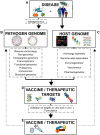The key role of genomics in modern vaccine and drug design for emerging infectious diseases
- PMID: 19855822
- PMCID: PMC2752168
- DOI: 10.1371/journal.pgen.1000612
The key role of genomics in modern vaccine and drug design for emerging infectious diseases
Abstract
It can be argued that the arrival of the "genomics era" has significantly shifted the paradigm of vaccine and therapeutics development from microbiological to sequence-based approaches. Genome sequences provide a previously unattainable route to investigate the mechanisms that underpin pathogenesis. Genomics, transcriptomics, metabolomics, structural genomics, proteomics, and immunomics are being exploited to perfect the identification of targets, to design new vaccines and drugs, and to predict their effects in patients. Furthermore, human genomics and related studies are providing insights into aspects of host biology that are important in infectious disease. This ever-growing body of genomic data and new genome-based approaches will play a critical role in the future to enable timely development of vaccines and therapeutics to control emerging infectious diseases.
Conflict of interest statement
KLS and RR are employed by Novartis Vaccines.
Figures

Similar articles
-
Recent Advances in Genomics-Based Approaches for the Development of Intracellular Bacterial Pathogen Vaccines.Pharmaceutics. 2022 Dec 31;15(1):152. doi: 10.3390/pharmaceutics15010152. Pharmaceutics. 2022. PMID: 36678781 Free PMC article. Review.
-
Integration of Novel Materials and Advanced Genomic Technologies into New Vaccine Design.Curr Top Med Chem. 2017;17(20):2286-2301. doi: 10.2174/1568026617666170224122117. Curr Top Med Chem. 2017. PMID: 28240182 Review.
-
The use of genomics in microbial vaccine development.Drug Discov Today. 2009 Mar;14(5-6):252-60. doi: 10.1016/j.drudis.2008.12.007. Epub 2009 Jan 15. Drug Discov Today. 2009. PMID: 19150507 Free PMC article. Review.
-
Targeting infectious diseases in the genomics era.Curr Opin Investig Drugs. 2006 Aug;7(8):695-8. Curr Opin Investig Drugs. 2006. PMID: 16955679 No abstract available.
-
[Infectious diseases--new horizons].Harefuah. 2012 Aug;151(8):483-7, 496. Harefuah. 2012. PMID: 23350296 Review. Hebrew.
Cited by
-
Intractable problems require novel solutions: it's time to get serious about developing a gonorrhoea vaccine.Sex Transm Infect. 2016 Dec;92(8):561-562. doi: 10.1136/sextrans-2015-052378. Epub 2016 Apr 1. Sex Transm Infect. 2016. PMID: 27037185 Free PMC article. No abstract available.
-
Universal fungal vaccines: could there be light at the end of the tunnel?Hum Vaccin Immunother. 2012 Dec 1;8(12):1758-63. doi: 10.4161/hv.21838. Epub 2012 Aug 24. Hum Vaccin Immunother. 2012. PMID: 22922769 Free PMC article. Review.
-
Computational Design of a Multi-Epitope Vaccine Against Porphyromonas gingivalis.Front Immunol. 2022 Feb 18;13:806825. doi: 10.3389/fimmu.2022.806825. eCollection 2022. Front Immunol. 2022. PMID: 35250977 Free PMC article.
-
Genetic analysis of SARS-CoV-2 isolates collected from Bangladesh: Insights into the origin, mutational spectrum and possible pathomechanism.Comput Biol Chem. 2021 Feb;90:107413. doi: 10.1016/j.compbiolchem.2020.107413. Epub 2020 Nov 4. Comput Biol Chem. 2021. PMID: 33221119 Free PMC article.
-
Recent Advances in Genomics-Based Approaches for the Development of Intracellular Bacterial Pathogen Vaccines.Pharmaceutics. 2022 Dec 31;15(1):152. doi: 10.3390/pharmaceutics15010152. Pharmaceutics. 2022. PMID: 36678781 Free PMC article. Review.
References
-
- Yang X, Yang H, Zhou G, Zhao GP. Infectious disease in the genomic era. Annu Rev Genomics Hum Genet. 2008;9:21–48. - PubMed
-
- Rappuoli R. Bridging the knowledge gaps in vaccine design. Nat Biotechnol. 2007;25:1361–1366. - PubMed
-
- Fleischmann RD, Adams MD, White O, Clayton RA, Kirkness EF, et al. Whole-genome random sequencing and assembly of Haemophilus influenzae Rd. Science. 1995;269:496–512. - PubMed
Publication types
MeSH terms
Substances
Grants and funding
LinkOut - more resources
Full Text Sources
Medical

